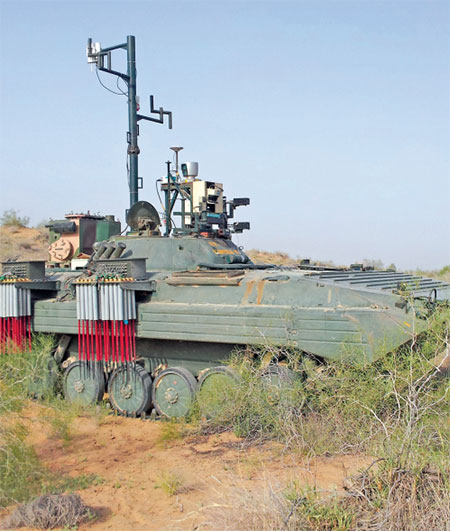Technology complements manpower, doesn’t replace it
 Col Mandeep Singh (retd)
Col Mandeep Singh (retd)
In 2022, the Agnipath scheme was rolled out when a three-year hiatus in recruitment had already resulted in a shortfall of 1,80,000 personnel. The yearly intake for the army under the scheme is of 28,000 personnel with 25 per cent (7,000) of them being retained after a four-year period. Given that the annual retrenchment in the army is of about 70,000 personnel, it will lead to a further shortfall. Even so, the Indian Army (IA) celebrated 2023 as the year of transformation and right-sizing, with the stated aim of ‘optimizing manpower, which is being substituted by technological infusion and force multiplication achieved by integration of forces.’ The army planned to retrench an additional 1,00,000 personnel as part of the transformation.
General Manoj Pande, the then Army Chief had stated that the impact of ‘rightsizing’ of the Indian Army on combat units is limited and that it would not impinge on the security architecture along our active borders. However, it needs to be noted that in April 2023, the Integrated Defence Staff ordered a 10 per cent reduction in combat units.
This cut in combat units was not surprising as in 2018 itself the then Chief of Army Staff General Bipin Rawat had announced at the Army Commanders’ Conference that the transformation and rightsizing of the Indian Army would entail not only the ‘tail’ alone being trimmed, but even frontline infantry battalions would be trimmed.
General Rawat had opined that the IA would leverage technology to increase surveillance through a multilayered network of satellites, unmanned aerial vehicles (UAV), improved battlefield surveillance radars (BFSR), quick reaction teams (QRT) for varied terrain and a reduced sensor-to-shooter loop that includes integral helicopter assets complemented by designated offensive and mobility airpower assets from the Indian Air Force (IAF).
Echoing him, General Pande emphasised that the robust counter-infiltration posture along the LC (line of control) and the surveillance grid along the LAC (line of actual control) is based on an extensive network of surveillance devices and other niche technologies. But what are these technologies that are expected to deliver and help cut manpower?
Before going further it would serve us well to remember that in early 2020 General MM Naravane, the then Army Chief, had stated that while “the icons of the 20th-century warfare like main battle tanks and fighter aircraft are on their way out and that the battle winning factor in future combat may not be numerical equivalence but technological superiority… technological capacities in enabling domains like AI (artificial intelligence) and cyber will decisively tip the military balance…” It is a different matter that Galwan proved otherwise as it was the conventional army that came to the rescue.
But there is no denying the fact that warfare, like everything else, has evolved and continues to evolve with its conduct getting shaped by technological advancements. New and emerging technologies such as precision munitions, unmanned systems and advanced communications coupled with cyberspace and AI are making new warfighting systems available that have brought greater lethality and destruction. These systems enable remote delivery of strikes with greater precision. Unmanned systems have proliferated and play an important role in the battlefield. Some even believe that the remote delivery of explosive force with great precision has made the mass army obsolete as it is no longer required to bring large forces onto the battlefield to engage targets.
New Technologies
In 2021, the United States Congressional Research Service (CRS) identified six leading military technologies: AI, lethal autonomous weapons (LAWS), hypersonic boost glide weapons, directed energy (DE) weapons, biotechnology and quantum computing as being of strategic importance. Automation, added to these technologies, will be the biggest disruptive force in the coming years and will impact defence forces hugely.
These technologies are already being used by most armies with unmanned systems, AI and precision strike weapons making an impact on the battlefield. The oft-quoted examples of Azerbiajan and Ukraine refer to the use of drones as being enablers that help win wars.
While technology may be an enabler that helps win wars, the question that needs to be asked is—can technology help replace manpower and win wars? This is important as the Indian Army plans to leverage technology to cut down manpower, and still retain combat proficiency. This was amplified in a recent article quoting the 20th Standing Committee on Defence report. According to article, Committee was told by the army representation that: ‘For example, let us say there is a hill feature which we are occupying. Today we occupy that hill feature with 120 men which is a company. But if that same company is given technology which ensures that it has got a complete transparency within 2000 meters of what is available there and has got weapon systems to engage, it can do the same task with about 80 men. That is what we are looking at in the future.’

A similar exercise was proposed by the United States Army in 2014 when Gen. Robert Cone, head of the Training and Doctrine Command, revealed that the US Army was studying the possibility of reducing the size of a brigade from 4,000 soldiers to 3,000 in the coming years. One of the proposed methods to cut manpower was to use support robots to include autonomous vehicles, autonomous aircraft and other autonomous robots like the LS3 ‘robot mule’ to replace manned systems. In 2015, the plan to use LS3 Mule was shelved as it was found impractical.
Given the experience of the US Army, can a similar exercise work for the Indian Army?
As regards the assumption that a technologically advanced army is superior to a low-tech army, there are enough examples from Korea to Afghanistan and Gaza to Yemen that offer an answer to the contrary. Despite having the most technologically advanced army, the US Army has had the ignominy of leaving many a battlefield after low-tech armies or loosely organised groups of armed militias refused to go down. Even the Russia-Ukraine conflict has now degenerated into a slugfest with no clear end in sight. Thus, assuming that technology is the silver bullet that will save manpower and help win wars may not be correct.
Does technology help cut down manpower?
Technology will not necessarily cut down on manpower. More often than not, the manpower cut by introducing automation and new-tech systems gets transferred to the support system that is required to support and sustain the automation. This keeps the overall manpower requirement at almost the same level. It is not known if any study has been carried out to identify the support staff required for new-age weapons by the IA but Daniel Vardiman in Is cutting-edge military tech really cheaper than manpower? gives the surreal example of the impact of automation on US Navy systems that can be used as a reference.
You must be logged in to view this content.

